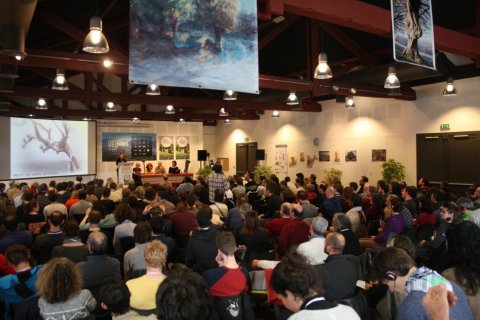The 2nd European Symposium on Pollarding was held in Sare, France from the 1st to the 3rd of March 2018. It was organised by the French Agroforestry Association (AFAF), Euskal Herriko Laborantza Ganbara (EHLG), Maison Botanique de Boursay and Arbre et Paysage 32, with support from the European Agroforestry Federation (EURAF), the World Agroforestry Centre (ICRAF) the Organic Research Centre (ORC) and the AFINET project.
The meeting was attended by over 250 delegates from a wide array of profiles and more than 10 countries (France, Spain, United Kingdom, Belgium, Italy, Sweden, USA, Netherland, Morocco, etc.), showing a keen interest in the subject. Presentations were simultaneously translated between French, English and Basque. Several of the French and UK AFINET RAIN members attended the symposium and could actively contribute to the exchanges, in relation to key bottlenecks that were identified within the project and especially the management of agroforestry trees in relation to the development of locally-based market channels.
The purpose of this symposium was to establish a better understanding of the potential of pollarding practices for sustainable and resilient landscapes, and to showcase examples of concrete developments on the ground. Speakers presented experiences from across Europe (and beyond) in order to provide the audience with the necessary tools to design and manage efficient systems at multiple scales, and (re)integrate pollards and their products in the farm's economy. The symposium also provided practical experiences through 4 workshops dealing with the creation of new pollards, current and future perspectives for mechanisation of management operations, woodchip for animal bedding, and the restoration of old pollards. The event was closed by a round table with practitioners, researchers, and decision makers. The subject was: "The road ahead: what future for pollards and what means of action?" Policy, technical and financial aspects were discussed.
This event aimed to encourage the return of pollards in the agricultural (and political) landscapes. The high level of contributions and exchanges was a testimony that this objective is on the way, and that pollards provide many opportunities for advanced agroforestry developments. Nevertheless, there is still a wealth of questions to be explored and no magic pill for pollards. There is a simple answer to the question, “how to support the future of pollards in Europe's rural landscapes?” Namely, reinforce the network of practitioners and researchers, enhance partnerships, and work through the society component (farmers, advisors, institutions, policy makers, citizens etc.). Just what AFINET and its members are here for!
The proceedings and videos of the event will be available soon on the webpage of the event (in French).












